Richmond Hobson
Richmond Hobson
Valiente! The Sinking of the Merrimac
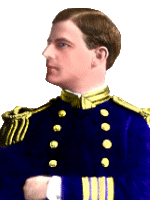 The hide-and-seek action that ultimately ended with the naval battle at Santiago two months into the Spanish-American War started with the initial declarations of war by Spain on April 21, 1898, and the United States on April 25th. With the opening declaration of hostilities, Spain moved swiftly to protect its citizens in the Caribbean. Beyond the fleet at Manila, the remainder of the once-mighty Spanish Armada was located in Spain and off the Cape Verde Islands.
The hide-and-seek action that ultimately ended with the naval battle at Santiago two months into the Spanish-American War started with the initial declarations of war by Spain on April 21, 1898, and the United States on April 25th. With the opening declaration of hostilities, Spain moved swiftly to protect its citizens in the Caribbean. Beyond the fleet at Manila, the remainder of the once-mighty Spanish Armada was located in Spain and off the Cape Verde Islands.
The flotilla at home was undergoing maintenance and repair at Cadiz, Spain. These ships would not be battle-ready for at least a month, so the defense of the Caribbean was delegated to the Cape Verde flotilla.
Rear-Admiral Pascual Cervera y Topete was surprised and dismayed when he received orders to lift anchor at his haven in the Cape Verde Islands off the coast of West Africa and proceed to the West Indies (Caribbean). “This is a very risky adventure, for the defeat of my ships in the Caribbean could result in great danger for the Canaries, and perhaps the bombardment of our coastal cities,” he wired back to Madrid. “Any division of our fleet, and any separation from European seas, is a strategic mistake.”
Admiral Cervera was a respected naval officer and not a man fearful to do his job, but the orders sending his flotilla to meet the American warships in the Caribbean gave him an ominous foreboding of disaster. When his appeal to Madrid was denied, he dutifully hoisted anchor on April 29, 1898, and set a course for Cuba. Before his departure, he registered his concern one more time, wiring Madrid that,
“Nothing can be expected of this expedition except for the total destruction of our flotilla. With a clear conscience, I go to the sacrifice, but I cannot understand the (Spanish) navy’s decision.”
As quickly as the media in the United States heard the news that Admiral Cervera’s ships were heading west, journalists worked up a frenzy of fear and dread, proclaiming in large headlines that the Spanish Armada was on its way and would bombard American coastal cities within two weeks. Despite the fact that the “Armada” actually consisted of only four outdated cruisers and three smaller torpedo boats, the news reports quickly sensationalized the coming conflict to epic proportions. The panic and public outcry that followed prompted immediate naval action at home. Even as Admiral Dewey was en route from China to Manila Bay for the infamous battle of May 1, 1898, preparations were underway to move the U.S. Navy’s Atlantic fleet to the Caribbean.
Navy Secretary John D. Long was convinced Cervera and his ships would most likely head for San Juan, Puerto Rico on the eastern border of the Caribbean, though he left open the possibility that the Spanish Admiral might instead elect to steam straight for Havana. The Atlantic fleet was under the command of US Rear Admiral William T. Sampson, a worthy opponent for Admiral Cervera. Sampson proposed quick strikes, first to capture Havana, then a rapid voyage to shell and capture San Juan. He reasoned that such a move would deny the Spanish flotilla any safe haven when they arrived in the Caribbean, projected by Secretary Long to be on or near the date of May 10th.
Once again, however, it was the media that would dictate the order of battle. Public panic and the cry for the protection of American coastal waters prompted Long to split Sampson’s fleet, pulling the battleships Texas, Massachusetts, and Iowa back to Hampton Roads, Virginia as a “flying squadron” under Commodore Winfield Scott Schley. Sampson’s other warships were limited to blockade duties around the island of Cuba, further stripped by the transfer of two of his cruisers to support efforts of a naval militia under Commodore John Howell that was assigned routine patrol duty of the Atlantic coastline from Maine to Florida.
Those first two weeks of the Spanish-American War were filled with frustration and boredom in the Caribbean. The inaction was further compounded when the sailors of Sampson’s fleet began hearing the glorious reports of the victory at Manila Bay, half a world away. When Cervera’s flotilla had not arrived in the West Indies by Secretary Long’s predicted date of May 10th, the American commander, his officers, and his men were both disappointed and further frustrated. It was this continuing erosion of morale that prompted Captain McCalla of the Marblehead to engage his ships in the cable-cutting operation of May 11th, and that also prompted Captain Todd to send his vessels into Cardenas Harbor that same day. Both efforts had broken the boredom, but both had also ended in near disaster.
Feeling the same frustration as his men and with the Spanish flotilla proving to be a “no show”, Admiral Sampson chose to commence a reconnaissance of Puerto Rico.
The small island less than 3,500 square miles was located on the eastern fringe of the Caribbean and sat between Cuba and the expected flotilla from Cape Verde. Claimed for Spain by Christopher Columbus and colonized by Ponce De Leon, the people of Puerto Rico had begun requesting independence from Spanish rule. In 1897, Madrid granted the people of Puerto Rico a limited degree of self-government but resisted all demands for independence.
When Admiral Sampson began his reconnaissance in May 1898, the Spanish had three forts on the long, narrow island. On May 12th Sampson entered the harbor at San Juan on the western edge of the island. His fleet consisted of seven warships, a torpedo boat, a tug, and supporting supply vessels. Carefully the fleet maneuvered around the sunken hulks of two ships in the harbor at San Juan and proceeded towards the forts deep inside. Sampson had hoped to find Cervera’s ships at anchor inside the calm waters, but all he found as he circled the harbor three times, were three small gunboats.
As the fleet passed the enemy forts inside the harbor at San Juan, Admiral Sampson opened fire. In the brief battles that followed, Sampson’s ships neither rendered nor received any major damage. As the ships withdrew, however, an enemy shell exploded in the New York, killing two men and wounding seven. Discouraged, disappointed, and now running low on fuel, Admiral Sampson directed his fleet to return to Key West for resupply and repairs.
Steaming for Key West the day following his bombardment of San Juan, Admiral Sampson received some disappointing news. The U.S.S. Solace caught up to the American ships with a report that Admiral Cervera’s fleet had returned to Cadiz, in Spain. As the bulk of the American naval presence departed the Antilles, on May 14th the Spanish gunboats Conde de Venadito and Nueva Espana made a brief and generally ineffective sortie out of Havana. The following day the U.S.S. Porter caught up to Admiral Sampson bearing surprising news. The report he’d received two days earlier from the Solace was in error. Admiral Cervera’s squadron had indeed arrived in the Antilles and had been spotted at Martinique on May 12th, then in Curacao on the 14th. Also, on May 13th Commodore Schley’s flying squadron had left Hampton Roads for Cuba.
The news, rather than raising the excitement level, served only to add to the frustration. Low on fuel, Sampson had no choice but to continue his course for Key West. In the two weeks that followed, events moved rapidly in the Caribbean and the commander of the Atlantic fleet chaffed at the bit to return and meet the enemy. On May 18th the New York arrived in Key West and Admiral Sampson met briefly with Commodore Schley and ordered him to immediately steam for the harbor at Cienfuegos, the place he deemed the most likely destination of Admiral Cervera’s flotilla.
On the morning of May 19th, Admiral Cervera’s ships reached the entrance to Santiago harbor at the southeast end of the island of Cuba. It was the same day that the remainder of Admiral Sampson’s ships finally arrived in Key West. The following day the Navy Department notified Admiral Sampson that in all probability, reports of Cervera’s fleet arriving at Santiago were correct. It was anticipated that the enemy ships would proceed immediately for Cienfuegos, 300 miles, and a single day’s travel, further to the west. Based upon the location of Sampson’s ships in Key West and the route of the flying squadron under Schley, Cervera would be unmolested in this effort.
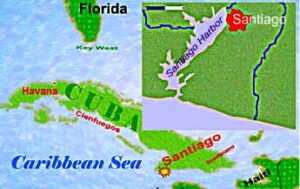 It wasn’t until midnight on May 21st that the flying squadron reached Cienfuegos, Commodore Schley’s warships riding out the darkness of night from a distance of about 20 miles. With daylight, however, his ships cruised closer to Cienfuegos, hoping to draw fire and confirm the presence of the enemy fleet. They met only silence. Somehow, once again, the Spanish fleet had eluded the Americans. Meanwhile, Admiral Sampson had returned to the Antilles, taking a blockading position in his flagship northwest of Cuba. Here he sent a message to Commodore Schley to proceed with his flying squadron to Santiago, where Sampson expected the squadron to arrive on May 24th. The search for the enemy fleet was still underway in the cat-and-mouse game that was now nearly a month old.
It wasn’t until midnight on May 21st that the flying squadron reached Cienfuegos, Commodore Schley’s warships riding out the darkness of night from a distance of about 20 miles. With daylight, however, his ships cruised closer to Cienfuegos, hoping to draw fire and confirm the presence of the enemy fleet. They met only silence. Somehow, once again, the Spanish fleet had eluded the Americans. Meanwhile, Admiral Sampson had returned to the Antilles, taking a blockading position in his flagship northwest of Cuba. Here he sent a message to Commodore Schley to proceed with his flying squadron to Santiago, where Sampson expected the squadron to arrive on May 24th. The search for the enemy fleet was still underway in the cat-and-mouse game that was now nearly a month old.
In fact, Admiral Cervera had taken his ships inside the narrow confines of Santiago Harbor. While Cienfuegos may have been preferable, his ships were low on coal, and the 300-mile voyage to Cienfuegos had to be postponed. That action not only sheltered the Spanish flotilla but left the Americans wondering where the mighty armada of the Spanish Empire had vanished.
Commodore Schley didn’t leave immediately for Santiago however, remaining outside Cienfuegos where he was joined at noon on May 22nd by Iowa and the Dupont. That afternoon he again sent his ships in closer to Cienfuegos, and this time he believed he could see the tops of an enemy man-of-war. Dupont was sent closer to reconnoiter and reported seeing several ships inside the harbor. Schley initially believed he had found Admiral Cervera. While continuing this blockade of Cienfuegos, the flying squadron was joined by additional American ships including the Castine, an armed yacht, and the aging collier Merrimac. On the evening of May 24th Schley ordered the Castine to take up a position in front of the harbor at Cienfuegos, though he was now convinced the Spanish fleet was not to be found nearby. The Dupont was returned to Key West, and the flying squadron proceeded towards the opening to Santiago harbor 300 miles away. Schley’s squadron included the Brooklyn, Iowa, Texas, Massachusetts, Marblehead, Vixen, Hawk, Eagle, and Merrimac.
 U.S.S. Merrimac
U.S.S. Merrimac
Not to be confused with the Civil War ironclad, the Merrimac was an aging collier the Navy purchased from T. Hogan & Sons of New York City on April 12, 1898, for the sum of $342,000. With no armaments and no armor, the 333-foot ship was pressed into a Spanish-American War support role a few weeks after purchase, under the leadership of Commander Miller.
Almost from the beginning of the Merrimac’s brief stint of US Naval service, it was plagued by problems. The ship broke down so frequently it was the butt of common jokes, and it was said that at times “the full engineer force of the Brooklyn was sent about to get her running again.”
On the day Schley set course for Santiago, he also sent a message to Admiral Sampson indicating there was no sign of the Spanish flotilla at Cienfuegos, and that his ships did not have enough coal to maintain a blockade at the opening to Santiago harbor. Unaware that the enemy warships were hidden within the narrow harbor, on May 26th Schley left St. Paul to watch the harbor, then set his squadron on a course for Key West. En route and about 40 miles from Santiago, the Merrimac broke down so completely it had to be taken under tow by the Yale.
In the meantime, Admiral Sampson learned that in fact, the enemy warships had taken anchor inside Santiago Harbor, and was determined to end the chase. He returned to Key West to obtain permission to personally take command of the blockade at Santiago Harbor and, he hoped, subsequently destroy Admiral Cervera’s squadron. His request granted, on May 29th Admiral Sampson departed Key West for Santiago de Cuba in his flagship U.S.S. New York. Joining his flotilla, in addition to the Mayflower and the Porter, was the newly arrived U.S.S. Oregon. (The powerful battleship Oregon, under the command of Captain Charles Clark, had left port in San Francisco on March 12th to travel around the Cape and arrive in Florida after a 14,700 nautical mile, 71-day race against time. The length of time it took the battleship to move from coast to coast would give rise to ideas for a shorter route, perhaps a canal in the narrow finger that joined the continents of North and South America.)
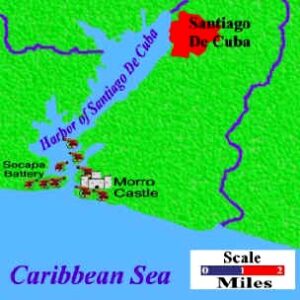 The Harbor of Santiago de Cuba is a long, narrow finger of the calm tropical sea that reaches inland nearly 10 miles. The shoreline is dotted with hidden coves and inlets, the perfect hiding place for small gunboats to protect any ships anchored inside. Access to the harbor from the sea could only be accomplished through a narrow inlet, only 200 yards across. The inlet itself was protected from the west by the Socapa Battery and on the eastern shore by the Morro Castle.
The Harbor of Santiago de Cuba is a long, narrow finger of the calm tropical sea that reaches inland nearly 10 miles. The shoreline is dotted with hidden coves and inlets, the perfect hiding place for small gunboats to protect any ships anchored inside. Access to the harbor from the sea could only be accomplished through a narrow inlet, only 200 yards across. The inlet itself was protected from the west by the Socapa Battery and on the eastern shore by the Morro Castle.
Before leaving Key West, Admiral Sampson had conferred with Captains Converse and Fogler, and Commodore Watson in efforts to format a plan of action. Unlike the harbor at Manila, there was no hope for American warships to enter and destroy the armada. By chance, more than by design, Cervera’s ships were stuck in a harbor that offered far more protection from attack than had they been able to continue to Cienfuegos. The culmination of these conferences was that, if the American ships couldn’t get in to destroy Admiral Cervera, then they would pen his ships inside. There were discussions about loading several small schooners with brick and rocks and then sinking them in the narrow inlet. Captain Converse thought of the broken down, 333-foot Merrimac, and suggested that it might provide a greater sunken barrier than several schooners.
As Admiral Sampson steamed towards the enemy in his flagship, the plan of action had been determined. All that remained was to figure out a way to accomplish it. The mission would be a dangerous one, sailing the large ship directly into the fire of enemy cannon, then sending it to the bottom of the sea. Perhaps the How would be far more difficult than the What, and even more critical than either perhaps, was the Who!
 Assistant Naval Contractor Richmond Pearson Hobson was a 28-year old lieutenant on the staff of Admiral Sampson as the New York steamed towards Santiago and the Spanish squadron of Admiral Cervera. Hobson was a unique individual, somewhat of a loner who kept to himself. At the age of 15 Hobson had entered the US Naval Academy at Annapolis and four years later graduated first in his class of 1889.
Assistant Naval Contractor Richmond Pearson Hobson was a 28-year old lieutenant on the staff of Admiral Sampson as the New York steamed towards Santiago and the Spanish squadron of Admiral Cervera. Hobson was a unique individual, somewhat of a loner who kept to himself. At the age of 15 Hobson had entered the US Naval Academy at Annapolis and four years later graduated first in his class of 1889.
It was during Hobson’s first three years at the Academy that much of his military personality would be shaped. A man of principle and dedication, some would say he went to the extreme. He was quick to report infractions, even when it involved midshipmen of his own class. During his first three years at Annapolis, classmates refused to talk to him except when official business required it. Hobson took the situation in stride, concentrating on his studies. In his senior year, his classmates extended an olive branch, inviting the 18-year old youth back into their fraternity. Having become used to the silent treatment, young Richmond informed his classmates that he was content with the status quo.
On the night of May 29th as New York headed back to Cuba, Admiral Sampson called the young officer to his quarters. Briefly, he outlined the plan to sink the Merrimac in the shallow waters of the entrance to Santiago Harbor, looking to the Naval Contractor for assurances as to the mission’s viability. Hobson listened intently, then requested time to plan such a mission. The following day, his work completed, Lieutenant Hobson presented his plan to Admiral Sampson.
Hobson’s plan was to fit out the aging collier with a series of explosive charges along the port side, ten of them in all. Under the cover of darkness, the Merrimac would then enter the harbor, slowly steaming to the shallow waters in the narrowest passageway, where the bow anchor would drop causing the current to swiftly turn the ship sideways. At this point the stern anchor would drop, holding the ship in place as the torpedoes were electrically detonated. With the port side facing into the harbor entrance, the holes opened by the torpedoes would fill with water swiftly in the onrushing current, and the Merrimac would sink in less than two minutes.
Admiral Sampson listened attentively to Hobson’s proposals, including the part of the plan that called for the young lieutenant to lead the mission personally. The Admiral approved it in its entirety, then set the men of the New York to the tasks of preparing the ten water-tight canisters that, when filled with nearly 80 pounds of brown powder, would be strapped below the water line on the port side of the Merrimac.
The following day, May 1st, Sampson’s ships arrived outside the harbor entrance, far enough away to be beyond the range of the guns at Socapa Battery or the Moro Castle. The Merrimac, repaired again at least for the moment, was brought alongside the New York so that Lieutenant Hobson could supervise the placement of the ten charges that would put the old ship “out of its misery”. He also carefully supervised the placement of the detonators that would trigger these charges.
The plan was for the mission to commence that very evening. One additional task remained. One man alone could not maneuver the 333-foot ship into the channel, drop the bow anchor, drop the stern anchor, and then detonate all ten charges. It was not a mission the Lieutenant could accomplish by himself…. this time Hobson would have to recruit assistance and work as part of a team.
Before Admiral Sampson issued his request for volunteers, he explained in explicit terms just how dangerous the mission would be. For all practical purposes, it appeared to be a suicide mission, attempting to sail the old ship directly into the guns of the enemy, sink her, and then escape and evade the enemy to return on a small catamaran carried on the deck of the doomed collier. His ominous speech concluded, the Admiral asked for volunteers. Three hundred men at once offered to risk their lives, including Captain Miller who was reluctant to turn command of his vessel over to another.
From the ranks of the eager sailors, Hobson selected six men. From New York, he selected Gunners Mate First Class George Charette and Coxswain Randolph Clausen. From the USS Iowa, he selected Coxswain J. E. Murphy. Remaining to guide their vessel Merrimac in its final voyage were three sailors who had joined the Navy a little over a month earlier, volunteers all of them. Machinist First Class George Phillips and Water Tender Francis Kelly would operate the engines of the Merrimac for one final operation, while Coxswain Osborn Deignan would man the helm to steer his ship to her final, glorious conclusion.
Preparations for the May 1st attack did not go well. It seemed nothing had ever gone smoothly for the Merrimac when it joined the US Navy. All ten charges were in place, the volunteers were ready to go, but there were only enough batteries to fire six of the ten explosive charges. To Hobson’s chagrin, the mission was postponed and work continued on the ship the following day.
As Hobson reviewed his plans, he felt he needed one more volunteer for the crew. Not only did he want a man to handle the task of dropping the stern anchor at the critical moment, but he also wanted an experienced sailor who could lead the others if anything should happen to himself. Hobson discussed the matter with the New York’s executive officer, then approached 29-year old Master-At-Arms of the Admiral’s flagship. Daniel Montague not only had seven years of experience in the United States Navy, prior to that service he had been a member of the British Royal Navy. Montague promptly volunteered for the dangerous mission.
In the early morning darkness of May 3rd, what would become one of the most historic missions since the Great Locomotive Chase of the Civil War began? In addition to Hobson and his seven volunteers, the Merrimac’s pilot and assistant engineer remained aboard for the first leg of the journey. As they moved the ship towards the harbor, Hobson began testing his explosive charges. To his frustration and dismay, only seven of the ten charges passed his initial test–he was going in at only 70%. Refusing to be delayed another day, Hobson ordered the Merrimac to continue, steaming at full speed of 9 knots.
As the Merrimac neared the harbor entrance she slowed momentarily. A small steam launch piloted by Cadet Powell steered close enough to take aboard the pilot and assistant engineer. The plan was for Powell to keep his launch close to the harbor entrance to pick up Hobson and his seven volunteers who would return on the small catamaran once the Merrimac had been scuttled.
It was near-total darkness as Hobson again commanded his doomed ship to move forward at full speed, riding the swell of the flood tide and hiding beneath a night no longer illuminated by the moon. Straight into the enemy guns, the warriors sailed, hoping against hope that the darkness would be their one ally in the dangerous waters of the enemy. It was not to be.
Within 500 yards of the narrow channel, the Merrimac suddenly came under heavy enemy fire. Even in near-total darkness, an enemy picket boat had discovered the ship. Despite the loss of the element of surprise, and in the face of the intense enemy fire, the volunteer crew of the Merrimac continued at full speed into the jaws of death. Within minutes a torrent of heavy cannon fire rained on the ship from all sides as it boldly entered the channel under the deadly guns of the Socapa Battery and Morro Castle.
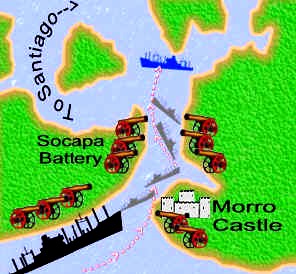 The aged ship shook with the repeated battery of heavy enemy shells but continued to steam valiantly ahead at full speed. Hobson himself later wrote, “The striking of projectiles and flying fragments produced a grinding sound, with a fine ring in it of steel on steel. The deck vibrated heavily, and we felt the full effect, lying, as we were, full-length on our faces. At each instant, it seemed that certainly the next would bring a projectile among us…I looked for my own body to be cut in two diagonally, from the left hip upward, and wondered for a moment what the sensation would be.”
The aged ship shook with the repeated battery of heavy enemy shells but continued to steam valiantly ahead at full speed. Hobson himself later wrote, “The striking of projectiles and flying fragments produced a grinding sound, with a fine ring in it of steel on steel. The deck vibrated heavily, and we felt the full effect, lying, as we were, full-length on our faces. At each instant, it seemed that certainly the next would bring a projectile among us…I looked for my own body to be cut in two diagonally, from the left hip upward, and wondered for a moment what the sensation would be.”
Near the stern anchor, Montague heard a heavy round crash into the structure, cutting the anchor lashings. At the helm, Coxswain Deignan yelled to Hobson, “She won’t respond sir! The tiller ropes have been shot away!” The same round had destroyed the collier’s all-important steering gear. Almost beyond navigation now, the ship continued forward, propelled by the momentum of its full-speed approach and the swift currents of the flood tide. And then the ship was in the channel, braving the continuing fire but moving ever closer to its destination as the crew remained at their posts. Despite the hail of fire that raked his ship, Hobson stood exposed on the bridge, stripped to his underwear, to monitor the situation. And then the Merrimac was sliding sideways, drifting away from the narrowest part of the channel and into deeper waters.
In the distance, the Spanish warships Colon and Oquendo added their fire to the fusillade from the shore batteries. Even when the Reina Mercedes sent two torpedoes to make direct hits on the Merrimac, nearly ripping it in half, Hobson and his volunteers stood faithfully at their stations. Above the din of battle, Hobson shouted the order and Murphy dropped anchor to halt the rapidly drifting ship. The stern anchor shot away; the doomed collier continued to drift as it dragged the lone anchor across the floor of the harbor. Kelly began knocking the caps from the sea valves as Hobson set to the process of detonating the explosive charges. The enemy fire had also destroyed batteries and detonators. Only two of the charges exploded into the early morning sky.
The lack of working explosives failed to sink the ship in the less than two-minute span previously plotted. Instead, it remained afloat for more than an hour, burning intensely and slowly going to its grave. Only a short distance from the shallow waters, the ship had come so close, only to fail in the end to accomplish its goal.
As the Merrimac burned, the catamaran fell upside-down into the harbor. Stripped to their underwear, the seven volunteers clung tenuously to their last vestige of haven, waiting for Hobson to leap overboard to join them. Beyond the mouth of the harbor Cadet, Powell continued to move through the darkness, waiting for the heroic men of the Merrimac to appear. Finally, as morning dawned, he turned his launch back to rejoin the fleet with tales of the incredible display of enemy firepower he had witnessed, and the sad report that apparently none of the brave sailors had survived the night. Within minutes, word had spread throughout Admiral Sampson’s ships. It was a morning for sorrow and mourning.
Inside the harbor, Richmond Hobson and his valiant sailors clung to their overturned catamaran, hoping and praying that the current would turn and sweep them back out to sea…and to safety. Instead, the tide only moved them closer to the enemy.
In that first dangerous hour, small arms fire from the nearby shore forced them to use their “raft” as a shield. But as the Merrimac burned out and slowly sank, the enemy fire tapered off, then stopped. In the early morning haze, the eight sailors noted the approach of a Spanish launch–and then it was upon them. Hobson yelled to the enemy, “Is there any officer in the boat to accept our surrender as prisoners of war.”
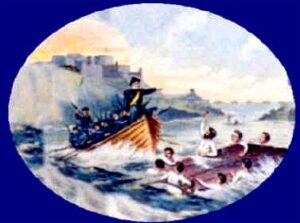 A gentlemanly-looking Spanish officer appeared and motioned towards the men, ordering his sailors to lower their weapons and help the American sailors aboard his launch. The officer that accepted their surrender was none other than Spanish Rear Admiral Pascual Cervera y Topete himself. As Hobson and his brave sailors surrendered to the enemy, Cervera surveyed the scene around him, taking in all that these young men had attempted to do, all that they had endured, and the risk that they had taken. Turning to them he spoke one word……Valiente!
A gentlemanly-looking Spanish officer appeared and motioned towards the men, ordering his sailors to lower their weapons and help the American sailors aboard his launch. The officer that accepted their surrender was none other than Spanish Rear Admiral Pascual Cervera y Topete himself. As Hobson and his brave sailors surrendered to the enemy, Cervera surveyed the scene around him, taking in all that these young men had attempted to do, all that they had endured, and the risk that they had taken. Turning to them he spoke one word……Valiente!
Later that afternoon a small Spanish tug left the harbor under a flag of truce. Steaming next to the New York, it halted while Cervera’s chief-of-staff, Captain Bustamente delivered a message from the Spanish admiral that Richmond Hobson and all of his men were safe. It was a dramatic example of compassion in a time of war, an enemy commander’s show of respect for true heroism even when exhibited by his enemy. The message delivered, Bustamente returned to Santiago with provisions of clothing and a small amount of money for the captured sailors.
Initially, the 8 prisoners were confined at Morro Castle, then later moved into the city of Santiago De Cuba. Three weeks later Daniel Montague became very sick and was moved to a hospital. (Though he recovered, the tropical illness contracted during his captivity, led to ill health in the years to follow and eventually contributed to his death in 1912.) On July 6th, after a desperate battle during which Admiral Cevera would attempt to escape the harbor with his fleet, all eight volunteers from the ill-fated Merrimac sinking were paroled in a prisoner exchange.
Richmond Hobson and his men came home to be hailed as heroes. On November 2, 1899, all seven of the sailors who had volunteered for the Merrimac mission were awarded Medals of Honor. As a Naval officer, Hobson himself was ineligible for his Nation’s highest recognition of uncommon valor. (Prior to 1917, the Navy Medal of Honor was reserved for presentation only to enlisted sailors and Marines.)
The lack of success of the mission to trap the Spanish fleet by sinking the Merrimac could not damper the coverage in the media, or the public adoration showered on Hobson and his heroes. Also, despite Hobson’s failure to receive the Medal of Honor, he became recognized as one of our Country’s greatest heroes of that Splendid Little War.
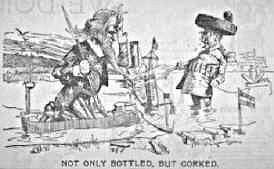 A special commemorative poster was later widely circulated depicting the history of that conflict. The photos of 10 of the leaders and heroes of that war were printed on that poster. Richmond Hobson’s photo was among the ten, positioned in the center just below a painting of the capture of his team by Admiral Cevera and the Spanish.
A special commemorative poster was later widely circulated depicting the history of that conflict. The photos of 10 of the leaders and heroes of that war were printed on that poster. Richmond Hobson’s photo was among the ten, positioned in the center just below a painting of the capture of his team by Admiral Cevera and the Spanish.
On October 8, 1898, just six months after Hobson’s heroic mission, Mr. and Mrs. Hilton of Westville, South Carolina were blessed with a baby boy. They named him after the hero of their day. Twenty years later their son would find himself facing his own war in France, a war in which 20-year old Sergeant Hilton would earn the Medal of Honor. On the official roll of honor, his name is listed as Richmond H. Hilton….his full name, however…Richmond Hobson Hilton.
In his post-war years, Hobson himself chose to leave his Naval career. In 1904 he was a Presidential elector from his home state of Alabama. From 1907 to 1915 Hobson served his state’s 6th Congressional District in the U.S. House of Representatives.
One year before Hobson’s namesake received the Medal of Honor, our Nation’s highest award underwent several major changes. Among these was a new provision that no longer restricted the award of the Medal to enlisted sailors and Marines. In future wars, heroes like Richmond Hobson would be recognized for their courage, regardless of their rank.
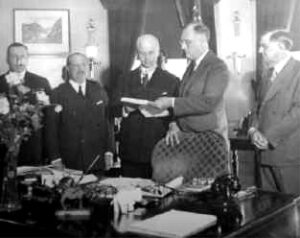 On April 29, 1933, Richmond Hobson was invited to the White House. The United States Congress had taken special action to add Hobson’s name to the Roll of Honor along with those of his valiant sailors. On that day, by that special act of Congress, President Franklin D. Roosevelt presented Richmond Hobson the Medal of Honor for his heroism 35 years earlier.
On April 29, 1933, Richmond Hobson was invited to the White House. The United States Congress had taken special action to add Hobson’s name to the Roll of Honor along with those of his valiant sailors. On that day, by that special act of Congress, President Franklin D. Roosevelt presented Richmond Hobson the Medal of Honor for his heroism 35 years earlier.
Elsewhere the occasion was surely a moment of unique pride for Richmond Hobson Hilton, the Spanish-American war hero’s namesake. With that award, Hilton became the only known person in history, named for a Medal of Honor recipient, to receive it himself.
This electronic book is available for free download and printing from www.homeofheroes.com. You may print and distribute in quantity for all non-profit, educational purposes.
Copyright © 2018 by Legal Help for Veterans, PLLC
ALL RIGHTS RESERVED
Heroes Stories Index
All Major Military Award Recipients (PDF)
Our Sponsors

